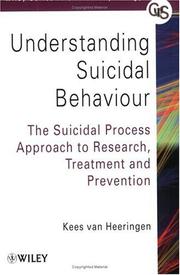| Listing 1 - 5 of 5 |
Sort by
|
Book
ISBN: 1316563200 1108677266 1108609031 1107148944 1316602907 Year: 2018 Publisher: Cambridge : Cambridge University Press,
Abstract | Keywords | Export | Availability | Bookmark
 Loading...
Loading...Choose an application
- Reference Manager
- EndNote
- RefWorks (Direct export to RefWorks)
Nearly one million people take their own lives each year world-wide - however, contrary to popular belief, suicide can be prevented. While suicide is commonly thought to be an understandable reaction to severe stress, it is actually an abnormal reaction to regular situations. Something more than unbearable stress is needed to explain suicide, and neuroscience shows what this is, how it is caused and how it can be treated. Professor Kees van Heeringen describes findings from neuroscientific research on suicide, using various approaches from population genetics to brain imaging. Compelling evidence is reviewed that shows how and why genetic characteristics or early traumatic experiences may lead to a specific predisposition that makes people vulnerable to triggering life events. Neuroscientific studies are yielding results that provide insight into how the risk of suicide may develop; ultimately demonstrating how suicide can be prevented.
Suicidal behavior --- Neurophysiology. --- Physiological aspects. --- Risk factors. --- Nervous system --- Neurobiology --- Physiology --- Risk factors in suicidal behavior --- Attempted suicide --- Suicide, Attempted --- Suicide attempts --- Unsuccessful attempted suicide --- Unsuccessful suicide attempts --- Self-destructive behavior --- Parasuicide

ISBN: 9780471491668 0471491667 Year: 2002 Publisher: Chichester: Wiley,
Abstract | Keywords | Export | Availability | Bookmark
 Loading...
Loading...Choose an application
- Reference Manager
- EndNote
- RefWorks (Direct export to RefWorks)
How can suicide be prevented and treated by mental health professionals? Understanding Suicidal Behaviour offers a clinical guide to the assessment, treatment and prevention of suicidal behaviour, from a new and useful theoretical perspective. The book presents the arguments and research evidence that suicidal behaviour is not just a response to current emotional crises, but is influenced by persistent characteristics that can be defined in psychological and biological terms. The approach in this book accommodates and goes beyond previous aspects thought important in suicidal behaviour, like mental disorder and social stress. The key concept of vulnerability may provide new approaches to treatment to supplement the existing treatments, which are of limited efficacy. Challenges professionals to understand suicidal behaviour from a basis of vulnerability, personality, and development – and as a process that includes social, biological, and psychological interactions. Offers ways in predicting suicidal behaviour and indicating earlier, effective interventions. Cutting edge discussion of implications for the study and treatment of suicidal behaviour, by some of the leading authorities in the field "...warrants a place on the shelf of any suicidologist, clinician or researcher with an interest in suicidal behaviour...the editor and contributors ought to be commended on a comprehensive and lucid volume." British Journal of Clinical Psychology
Book
Year: 2001 Publisher: Chichester ; New York, NY ; Weinheim : John Wiley,
Abstract | Keywords | Export | Availability | Bookmark
 Loading...
Loading...Choose an application
- Reference Manager
- EndNote
- RefWorks (Direct export to RefWorks)
Comportement autodestructeur --- État émotionnel --- Prevention --- Suicide --- Traitement --- Comportement autodestructeur --- État émotionnel --- Prevention --- Suicide --- Traitement
Book
ISBN: 9781316563205 9781107148949 9781316602904 Year: 2018 Publisher: Cambridge Cambridge University Press
Abstract | Keywords | Export | Availability | Bookmark
 Loading...
Loading...Choose an application
- Reference Manager
- EndNote
- RefWorks (Direct export to RefWorks)
Book
Year: 2017 Publisher: Gent Vlaams Expertisecentrum Suïcidepreventie (VLESP)
Abstract | Keywords | Export | Availability | Bookmark
 Loading...
Loading...Choose an application
- Reference Manager
- EndNote
- RefWorks (Direct export to RefWorks)
In Vlaanderen zijn heel wat cijfers beschikbaar over de prevalentie van geestelijke gezondheidsproblemen, suïcidegedachten, suïcidepogingen en suïcide. VLESP bundelt jaarlijks de meest recente en betrouwbare cijfers en prevalentiestudies in een uitgebreid epidemiologisch rapport. Naast de Vlaamse cijfers wordt ook ingegaan op de nationale en internationale context.
| Listing 1 - 5 of 5 |
Sort by
|

 Search
Search Feedback
Feedback About UniCat
About UniCat  Help
Help News
News